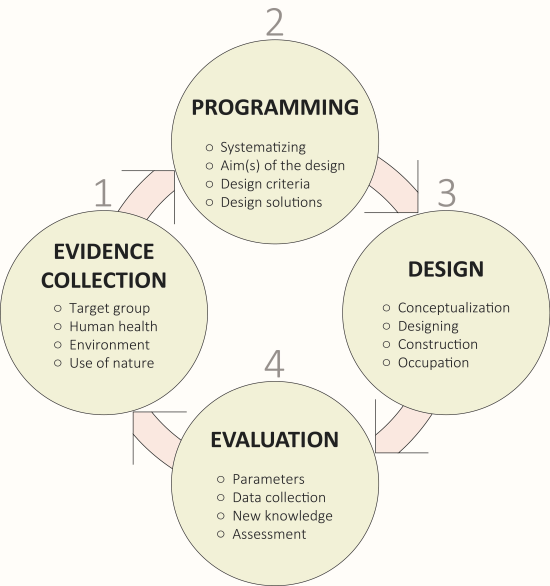Health design in landscape architecture
The research group’s work in the field of ‘health design in landscape architecture’ is based on the health-beneficial relationships between the following four core parameters:
- Target group
- Human health
- Environment
- Use of nature
The target group are the individuals who are to use and benefit from the design. Human health refers to health-related natural exposure. The environment includes natural surroundings on very different scales, ranging from large natural areas to small pocket parks. Use of nature includes specific nature-based treatment programmes or health-promoting activities.
To increase the health potential, it is important to ensure consistency between the intended use and the design of the environment in relation to the specific user group. Therefore, tools and design guidelines are needed to collect the most current and relevant evidence regarding health design in landscape architecture.
The research group has developed, applied and validated a process model for working with evidence-based health design in landscape architecture (EBHDL). This model illustrates a work process and is intended as a guide for organizing the design process when the goal is to ensure health-promoting landscape architecture.

Figure: The latest version of the EBHDL process model developed in 2020. It consists of four steps that the landscape architect/project manager can follow.
In the first step, evidence is collected in relation to the four core parameters. Evidence is understood as documentation in the form of scientific theories, data and results that support explanations or relations, as well as experiences from practice, rules and recommendations and knowledge associated with a given place. The collected evidence is systematized and based on this systematization, a final aim (or aims) for the design is formalized and a number of criteria are set for what the environment must be able to deliver. These criteria are further concretized through a number of design solutions that seek to link the collected evidence and the design criteria to the site conditions. The design solutions are conceptualized on site through diagrammatic drawings and/or overall descriptions of function, structure and form. The final design proposal can then be prepared. After the construction phase, the natural environment can be used by the target group in accordance with the health-promoting objective.
It is important to ensure that the designed environment meets the original aim(s) and design criteria. Post-occupancy evaluation is therefore recommended based on parameters and data in relation to the original aim(s) and design criteria. The data collected post-occupation will provide results and experience that can be used as new knowledge and documentation in other projects. It can also be used as a basis for making adjustments in the design of the environment.
Nature-based use and treatment
The research group has developed a nature-based treatment concept for stress recovery. The purpose of this concept is twofold: to strengthen the users' own resources through activities and support in the natural environment thereby establishing a healthy stress preparedness, and to increase their overall quality of life.
The treatment lasts ten weeks, with three weekly three-hour sessions. The treatment is offered all year round and takes place in a group of eight clients, led by two trained therapists and an assistant gardener.
The research group has conducted pilot studies with nature-based treatment for several target groups, including veterans with PTSD and people with eating disorders.
On the Nacadia-homepage you can read more about the nature-based treatment (in Danish).
Read more about the EBHDL model:
Stigsdotter, U.K. & Sidenius, U. 2020: Keeping promises: The goal of designing health-supporting urban green space, Landscape Architecture Frontiers, vol. 8, no. 3, pp. 78-89
Head of Research Group
 Ulrika K. Stigsdotter
Ulrika K. Stigsdotter
Professor MSO
E-mail: uks@ign.ku.dk
Tel.: +45 35331786
Mobile: +45 40110801
